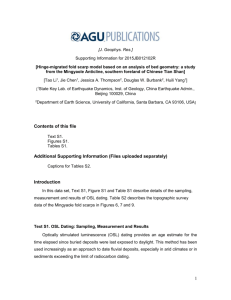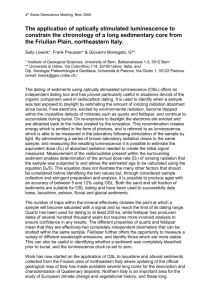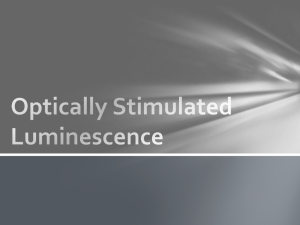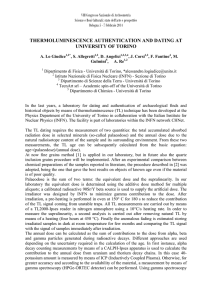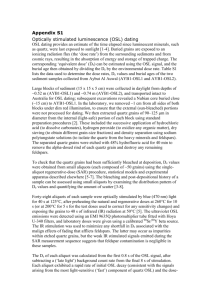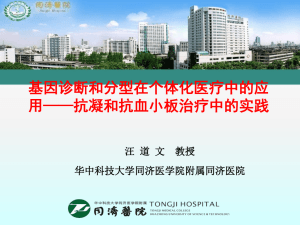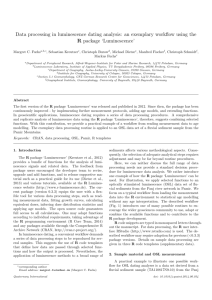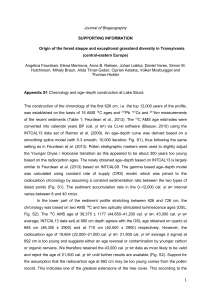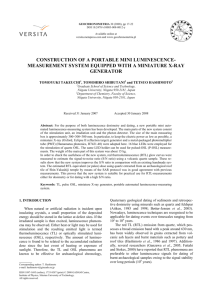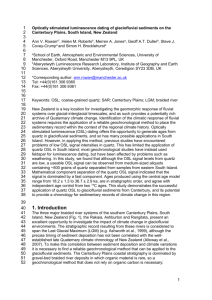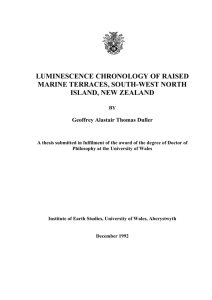bre12116-sup-0001-SupInfo
advertisement
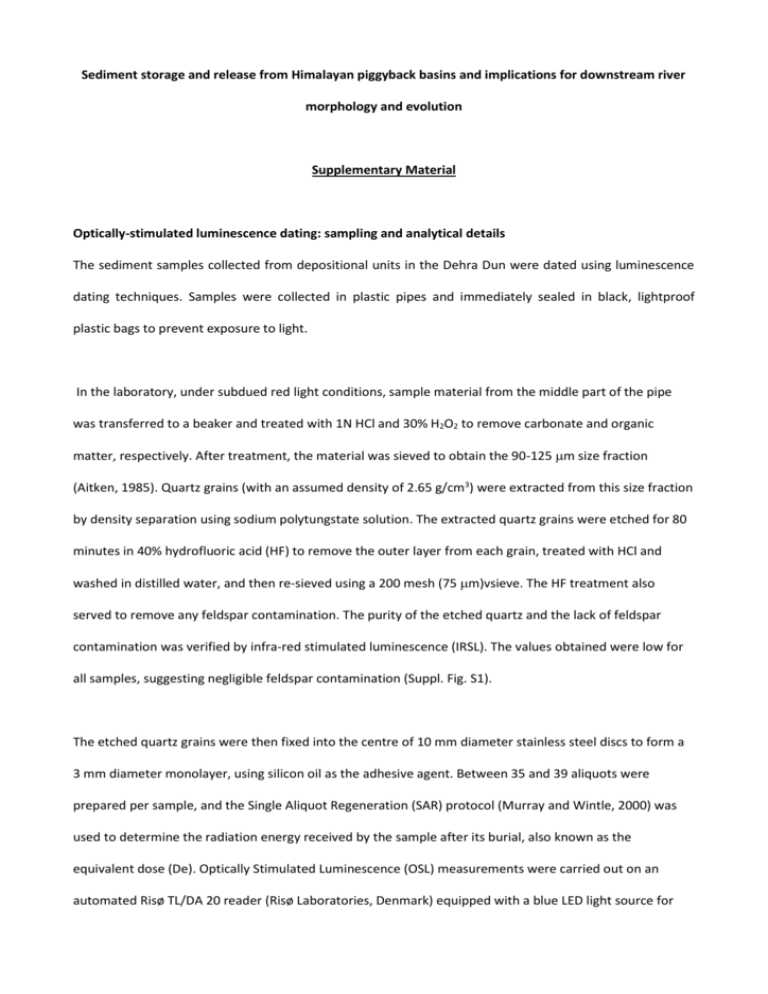
Sediment storage and release from Himalayan piggyback basins and implications for downstream river morphology and evolution Supplementary Material Optically-stimulated luminescence dating: sampling and analytical details The sediment samples collected from depositional units in the Dehra Dun were dated using luminescence dating techniques. Samples were collected in plastic pipes and immediately sealed in black, lightproof plastic bags to prevent exposure to light. In the laboratory, under subdued red light conditions, sample material from the middle part of the pipe was transferred to a beaker and treated with 1N HCl and 30% H2O2 to remove carbonate and organic matter, respectively. After treatment, the material was sieved to obtain the 90-125 m size fraction (Aitken, 1985). Quartz grains (with an assumed density of 2.65 g/cm3) were extracted from this size fraction by density separation using sodium polytungstate solution. The extracted quartz grains were etched for 80 minutes in 40% hydrofluoric acid (HF) to remove the outer layer from each grain, treated with HCl and washed in distilled water, and then re-sieved using a 200 mesh (75 m)vsieve. The HF treatment also served to remove any feldspar contamination. The purity of the etched quartz and the lack of feldspar contamination was verified by infra-red stimulated luminescence (IRSL). The values obtained were low for all samples, suggesting negligible feldspar contamination (Suppl. Fig. S1). The etched quartz grains were then fixed into the centre of 10 mm diameter stainless steel discs to form a 3 mm diameter monolayer, using silicon oil as the adhesive agent. Between 35 and 39 aliquots were prepared per sample, and the Single Aliquot Regeneration (SAR) protocol (Murray and Wintle, 2000) was used to determine the radiation energy received by the sample after its burial, also known as the equivalent dose (De). Optically Stimulated Luminescence (OSL) measurements were carried out on an automated Risø TL/DA 20 reader (Risø Laboratories, Denmark) equipped with a blue LED light source for stimulation, using the following measurement settings: pre-heat 240°C, cut-heat 160°C, test dose ~15% of expected De, blue light stimulation 40 s and Hoya U-340 detection filters. In the SAR protocol, the same aliquot is subjected to a series of cycles of measurements and the resulting sensitivity changes (due to repeated heating during measurement cycles) were normalized by a test dose signal. We first measured the natural luminescence (Ln) using 240oC pre-heat and 40 s blue light stimulation at 125oC, followed by the test dose luminescence signal (Tn) using 160oC cut heat and 40 sec blue light stimulation at 125oC for sensitivity correction. Subsequently, the regenerated luminescence signals were generated by applying different irradiation doses (Lβ1, Lβ2, Lβ3, Lβ0 and Lβ1), along with the corresponding test dose signals. Estimates of De were achieved by comparing the natural luminescence signal with those induced by laboratory irradiation, and the regenerated growth curve for each sample was constructed using Duller’s Analyst software, using an exponential fit for De calculation. This was done using the test dose value normalized fast component of the OSL (initial integral of 0.8 s) and the regenerated signals. The shine down curves (OSL intensity plotted as a function of light stimulation) and representative regenerated growth curves for samples LD1039-LD1042, LD1147, and LD1148 are shown in Suppl. Fig. S2. The disc-to-disc scatter (5–10%) is typical of that observed in quartz OSL measurement (Smith et al., 1990). The quartz shine down curve shows how the luminescence emitted by the mineral grains evolves as the electrons in the traps are emptied, rapidly for the first few seconds and then at a decaying rate. The growth curve is used to determine the laboratory dose that regenerates a luminescence signal that matches the intensity of the natural luminescence signal in the sample. Additional aliquots were prepared for sample LD1039 to conduct a dose recovery test. The aliquots were first bleached (similar to natural bleaching) for 100 sec by blue LED stimulation and a known quantity (133.33 Gy) of dose was applied using the calibrated beta source (Sr/Yr90) in the instrument. The given dose was recovered using the SAR protocol. The dose recovery test was carried out at various pre-heat temperatures (200, 220, 240 and 260°C), showing that the recovered value is always within error limits and does not show any systematic changes with pre-heat temperatures, and hence documenting the thermal stability of the quartz signal (pre-heat plateau). The results of the dose recovery test for this sample are shown in Suppl. Fig. S3. Our samples show a wide distribution of De values, perhaps due to partial bleaching during transportation. Thus, the abnormally high De values were omitted from subsequent calculations, and the De value was obtained from between 8 and 20 aliquots (out of 35-39 per sample). For the annual dose rate estimation, the concentrations of uranium, thorium and potassium in the samples were measured by XRF and the water content was determined by heating at 100oC. No measurements for cosmic ray contribution were carried out. The ages were calculated using AGE (Grun, 2009), which uses the depth of the sample below the surface to determine the cosmic dose rate, assuming a sediment density of 2000 kg/m3 using a standard value of 150 µ Gy. The ages were calculated using the weighted mean of De divided by the dose rate value. We argue that the weighted mean is a better estimate of age as it will depend upon the actual distribution of De values. However, we have provided the least De values and associated ages in Table 1. References AITKEN, M.J. (1985) Thermoluminescence Dating, Academic Press, London, 359 pp. GRUN,R. (2009) The ‘AGE’ program for the calculation of luminescence age estimates. Ancient TL, 27, 4546. MURRAY, A.S. & WINTLE, A.G. (2000) Luminescence dating of quartz using an improved single-aliquot regenerative-dose protocol. Radiation Measurements, 32, 57-73. SMITH, B.W., RHODES, E.J., STOKES, S., SPOONER, N.A., & AITKEN, M.J. (1990) Optical dating of sediments: initial quartz results from Oxford. Archaeometry, 32, 19-31. Supplementary Figures Fig. S1. IRSL signal for samples LD1039 to LD1042. Low values of the IRSL signal suggest that feldspar contamination in the samples is negligible. Fig. S2. Shine down curves (equivalent dose versus stimulation time, left panels) and regenerated growth curves (test dose normalized luminescence intensity versus laboratory beta dose, right panels) for equivalent dose determinations for samples LD1039 to LD1042, LD1147, and LD1148. Fig. S3. Results of dose recovery test for sample LD1039. The applied beta dose (133.33 Gy) was successfully recovered using quartz SAR protocol. The test was carried out at various pre-heat temperatures (200, 220, 240, and 260°C), which shows the thermal stability of the quartz OSL signal and the suitability of the material for OSL dating.
